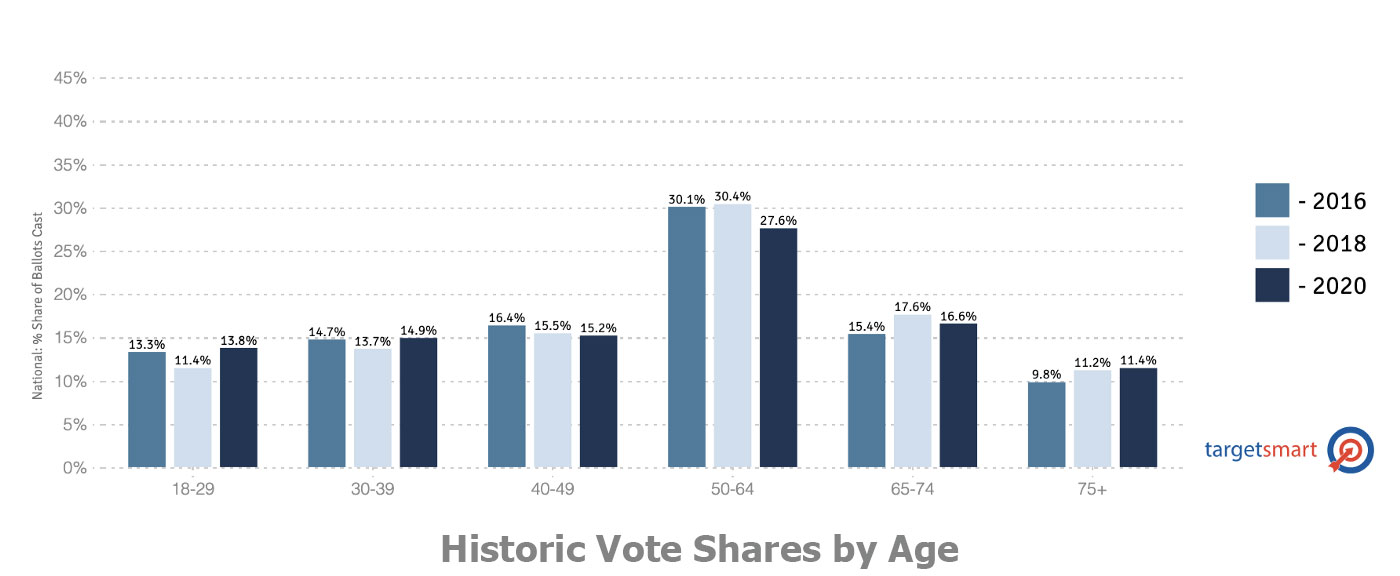By: Tom Bonier
The 2020 US election was anticipated as the most consequential in US history. The Capitol insurrection attempt on January 6th and subsequent GOP efforts to minimize the seriousness of the event while continuing to undermine the legitimacy of the election suggests that the ’22 midterms could surpass the importance of the 2020 elections. With these stakes in mind, we begin to focus on the electoral landscape for 2022, identifying decisive voting blocs. We begin with a group poised to have an outsized impact on the outcome of these critical elections: young Americans.
When considering the potential impact of young voters in the 2022 midterms, it’s important to understand the recent history of the youth vote in midterms. In ’14, Democratic enthusiasm generally lagged, with youth turnout lagging more than any other group. Voters under the age of 30 accounted for just 7.2% of all ballots cast. The end result? Republicans won the national popular vote for the US House by almost 6 points, adding 13 seats to their already substantial majority. The GOP also gained 9 seats in the US Senate.
Jumping ahead to the 2018 midterm elections, no age group saw a larger surge in turnout than voters under the age of 30. The youth vote drove the Blue Wave, as this group gave Democrats a margin of almost 2 to 1. In the end, voters under the age of 30 accounted for 11.4% of all votes cast, a 4.2-point increase over their 2014 vote share. Of course, 2018 saw Democrats recapture the House, winning the national popular vote by almost 9 points — a swing of almost 15 points from the previous midterm election.
Youth turnout surged again in 2020, as voters under the age of 30 made up 13.8% of all ballots cast, again providing a decisive edge for the Biden-Harris ticket, and helping to deliver Democratic control of the Senate.

Democrats face numerous structural challenges heading into next fall’s midterm elections. Between the gerrymandered US House districts, and the Constitutional gerrymander inherent in the structure of the US Senate, Democrats must win the national popular vote by a substantial margin just to hold onto their majorities in both chambers. What’s more, with redistricting looming and the GOP poised to control the process in key states, it’s conceivable that the congressional gerrymander will only worsen before next fall, necessitating an even larger popular vote margin to maintain control of Congress.
At a state level, several key states stand out as particularly exposed to swings in the youth vote. Arizona, California, Georgia, Nevada, and Texas all have youth vote shares above the national average. These states will be key battlegrounds for control of congress in 2022.
Of course, the Democratic coalition is much broader than the youth vote alone. Voters of color stand as a crucial voting bloc, and their turnout will be critically important in the 2022 midterms. What is important to understand here is the intersection between age and race/ethnicity. Voters of color are, on average, younger than white voters. 20% of all votes cast in the 2020 presidential election were cast by voters of color. Yet voters of color accounted for 30% of the youth vote in that same election. We expect to see this vote share rise in future elections. Engaging voters of color increasingly means engaging the youth vote.
This adds up to a simple truth — if youth voter turnout doesn’t approach 2018 levels, Democratic control of Congress could be in peril, yet at the same time, should Democrats build on the turnout successes of 2018 and 2020, their majorities in Congress could grow.